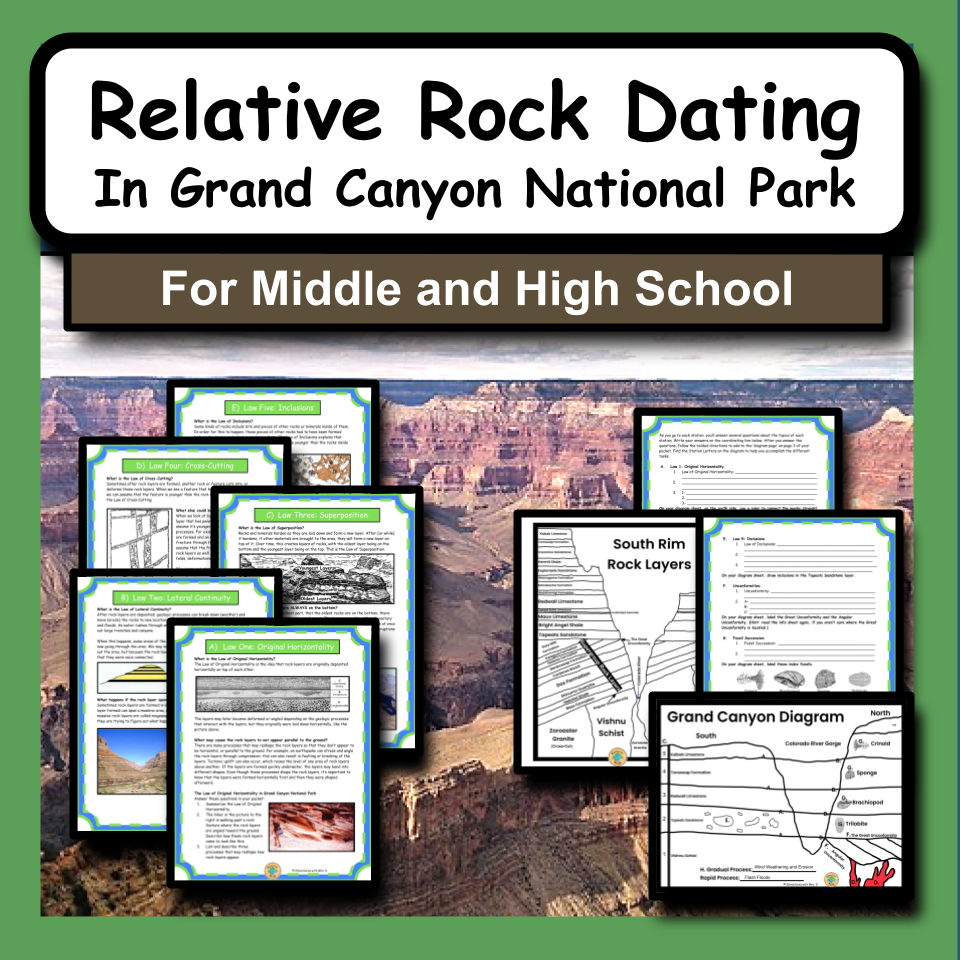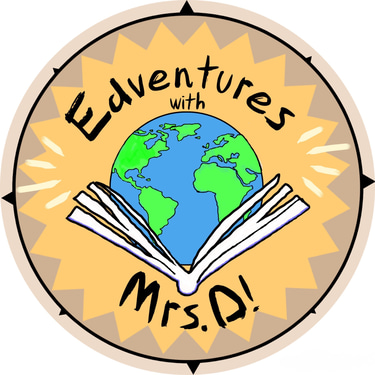
Relative Dating Rock Layers in Grand Canyon National Park Science Activity
For Middle and High School
$8.00$7.00
Unveil the mystery of the Earth's history with our immersive Relative Rock Dating Activity! Designed specifically for middle and high school students, this bundle features station activities, worksheets and detailed diagrams to guide them through the fascinating process of relative rock dating, taking inspiration from the geologic wonders within the Grand Canyon National Park. Elevate your geology lessons with this comprehensive and engaging educational tool that makes learning both fun and informative.
One look at Grand Canyon National Park and you know that geologic processes have immensely shaped the land. It is so unique because of its many rock layers, fossils and minerals. Scientists have been studying this canyon for years and they use many methods to relatively date the rock layers and geological events that have occurred in the canyon. By relative dating, we can develop a timeline of events to help us understand what happened in a certain area.
With this activity, students will first learn eight laws and principles that scientists use to conduct the relative dating method. They will go to eight 'stations' around the room and answer questions and add to a diagram at each station. Then, they will use what they learn to determine the order of 30 layers and geologic events in Grand Canyon National Park.
There are eight 'stations' in this activity, each with a different law, principle or topic related to relative dating. Students will answer questions and do a different activity for each station. (Directions are included in the student packet and on the station sheets.)
Here are the station topics and the concepts covered at each:
Law 1: Original Horizontality: Definition of Law and what may cause the rocks not to appear parallel
Law 2: Lateral Continuity: Definition of Law and megaseqences
Law 3: Superposition: Definition of Law and times when rock layers may get ‘out of order’ (i.e. metamorphic formation, uplift, eruptions, etc.)
Law 4: Cross-Cutting: Definition of Law and other things that may be considered a ‘cross-cut’ (i.e. fractures, faults, forms, unconformities, etc.)
Law 5: Inclusions: Definition of Law and examples of Inclusions (i.e. xenoliths, clasts, fragments, etc.)
Unconformities: Definition of Unconformities and types of Unconformities (i.e. Angular, disconformity, etc.)
Fossil Succession: Five ways that fossils can form and how fossils help with relative dating (index fossils)
Uniformitarianism and Catastrophism: Definitions of Uniformitarianism and Catastrophism and how we can use ideas from both to help with relative dating
As students complete each of these stations, they will answer 19 analysis questions, which summarize what they learned from all of the stations and they will add to a cross diagram of some of the rock layers in the Grand Canyon.
After they finish the stations, they will be given a second packet that includes a cross diagram of 30 of the rock layers, unconformities, events etc. in Grand Canyon. Students will put all 30 in order from oldest to youngest and they will write the law or principle that helped them figure out the order for each. This can be used as a quiz or bonus activity.
There are teacher tips provided to help you as you direct your students through this activity as well as detailed prep and procedure directions.
Typically, this activity will last several class periods for students to go through all of the stations and complete the second packet. The activity is designed so that students can pick up at a new station the next day and continue where they left off in their packets.
This product includes:
Intro and materials needed
Teacher Prep Directions
Teacher Procedure Directions
Answers to all Student Packets and Diagrams
Student Packet-Short reading, answer sheet and diagram sheet
Student Packet 2-directions, lists, table and diagram sheet
List of Station Topics and Concepts Covered at each
Websites and Citations
Teacher Tips
8 Station Reading Sheets and Directions
To do this activity, you will need:
Pencil
Copy of “Grand Canyon National Park Relative Ages of Rocks” and “Relative Dating the Grand Canyon’s Rock Layers” packet for each student
1 copy of each station sheet (8 total)
2-6 rulers
Colored pencils (colors don’t matter)
Optional: Tape, magnets, etc. to hang station sheets
Also, check out my Youtube Channel for FREE informational videos about the national parks along with FREE video guides for your students!
Join my email list here to learn about ways to encourage students to experience the content!
You can also follow me on Pinterest, Instagram, Facebook and YouTube!
If you have any questions, feel free to email me at edventureswithmrsd@gmail.com.
Thank you!
6th-12th
Science
General Science
National Parks
Earth Science
Geology
Rock Science
28 Pages
"I was looking for an engaging activity that would allow the students to collaborate and cover the rock layer information in multiple ways. This activity is perfect. The students moved around to stations. They read the information as well as answering questions, diagramming , and the review at the end of putting the layers in order really forced them to use what they learned. I especially liked the diagram that goes along with each station. I added a video at he start of the Grand CAnyon to really help them visualize what they were studying." Sara E.
"Thank you so much for taking the time to make a great resource!" Chrystie O.
